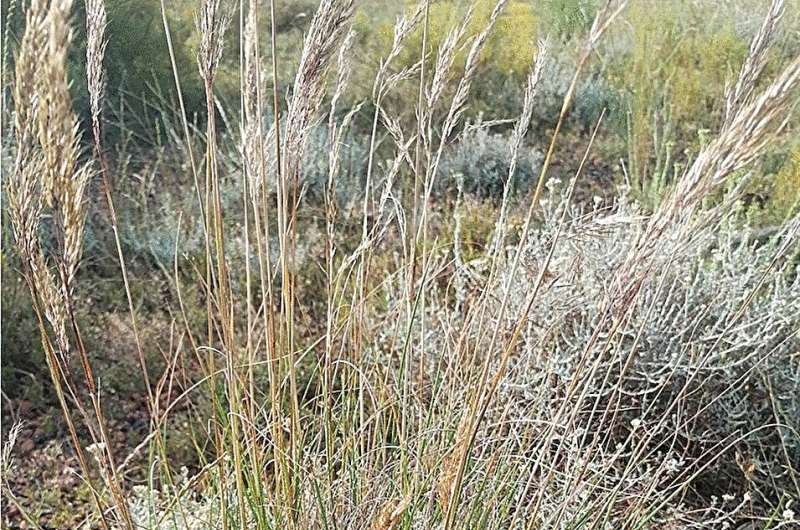This article has been reviewed according to Science X's editorial process and policies. Editors have highlighted the following attributes while ensuring the content's credibility:
fact-checked
peer-reviewed publication
trusted source
written by researcher(s)
proofread
South Africa's Agulhas long-billed lark: Adapting, surviving despite farming taking over their nesting grounds

The Agulhas long-billed lark (Certhilauda brevirostris) is only found in South Africa. It builds nests on the ground mainly in Renosterveld fynbos, a type of vegetation filled with grasses and wild spring flowers that is critically endangered by agricultural expansion. The University of Cape Town's FitzPatrick Institute of African Ornithology recently published the first study into the nesting practices of the lark. We talk to one of the researchers, Robert Thomson, about the future of this bird.
How many Agulhas long-billed larks are left? Why are they important?
The Agulhas long-billed lark is a South African endemic species restricted to the Agulhas plains, an area of about 15,000km² on the southern coast within the Western Cape province. While larks are generally "little brown birds" that are often difficult to identify, the Agulhas long-billed lark has a longer beak. It also makes a distinctive sound that makes it easier to find and recognize. Because it only occurs in a small part of South Africa, the Agulhas long-billed lark presents ecotourism value and forms part of South Africa's unique biodiversity.
However, the area in which this lark occurs has been almost fully transformed into agricultural land. The native vegetation, known as Renosterveld, mainly persists as small fragments.
Recent estimates put the population of the species at roughly 203,000 to 368,000 individual birds. These birds are classified as near-threatened because they are only found in this small area of the world. Land use changes or any freak occurrence could be detrimental to the whole species and to other species that depend on this vegetation.
Prior to this study, nothing was known about the nesting biology, or any of the nesting practices of the Agulhas long-billed lark. Finding the larks' nests was no easy task. The species is relatively shy and locating the nests often took hours of patient observation.
Can this lark survive outside the Renosterveld?
Our research suggested that these larks prefer to nest in Renosterveld, with 66% of nests found in Renosterveld patches—even in small patches growing along fence lines. But Renosterveld makes up less than 10% of the landscape. However, we also found nests in other field types, which shows that this lark has adapted to nesting outside its natural habitat.
The larks are frequently seen foraging in agricultural fields and are a common bird species in the area. Even though they prefer the threatened Renosterveld as a nesting habitat, the small patches of Renosterveld that remain and the lark's adaptation to nesting in fields seems to be keeping the population going.
What kind of conservation does the lark need?
It is critical that all remaining patches of the unique Renosterveld are protected. There may well be a threshold of the amount of natural Renosterveld below which the lark would not be able to persist.
Indeed, there are other endangered bird and animal species who depend on Renosterveld and are of even more concern to conservationists, such as the southern black korhaan, black harrier and Stanley's bustard. These birds have far bigger distributions, but the Agulhas Plains are also their main habitat and losing more Renosterveld would be a massive blow to their long-term conservation.
Where possible, natural vegetation should be allowed to grow to increase the size of Renosterveld patches. Fence-lines should be allowed to be wild, creating a more suitable habitat for the nesting birds.
Fire management in Renosterveld is important. Renosterveld needs to be burnt at regular intervals. In areas where the larks live, burning should not take place during their peak nesting time from August to November.
What threats do the eggs and tiny birds face?
In the nests we monitored, we found that only 14% of the larks survived long enough to take flight. The rest were eaten by predators. Bird species that nest and breed on the ground often lose a high proportion of their nests to predators, but lark nests are very well concealed. Many predators on the Agulhas Plain rely on their eyesight to locate nests, so this camouflage generally pays off. As soon as the chicks are mobile, but before they can fly, they leave the nest area to hide under small bushes nearby, which makes them even harder to spot.
The high rates at which this lark's eggs are being eaten may be because the small Renosterveld patch sizes make it easier for predators to find the nests. However, more research is needed into this.
Larks are small songbirds, and so animals who prey on nests also prey on the adult birds. Therefore, if an adult bird chose to aggressively defend its nest by mobbing (squawking or flying at predators to chase them away), it might well be eaten itself. The larks may be choosing instead to incur a short-term loss of chicks or eggs.
Larks appear to live reasonably long—up to 13 years—so missing a nesting season but surviving another year might be a better strategy. Nevertheless, evidence from videos at the nests showed that reptile predators such as snakes and tortoises provoked a strong mobbing response from larks. Why this occurred is still unclear, and there is a lot about the predator dynamics in the Renosterveld that needs further investigation.
More information: Sanjo Rose et al, The breeding ecology of the Agulhas Long-billed Lark: an endemic bird dependent on the remnant Renosterveld of the Western Cape Province, South Africa, Journal of Ornithology (2023). DOI: 10.1007/s10336-023-02123-2
Journal information: Journal of Ornithology
Provided by The Conversation
This article is republished from The Conversation under a Creative Commons license. Read the original article.![]()





















